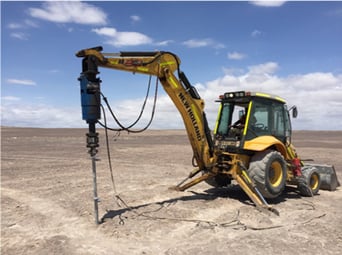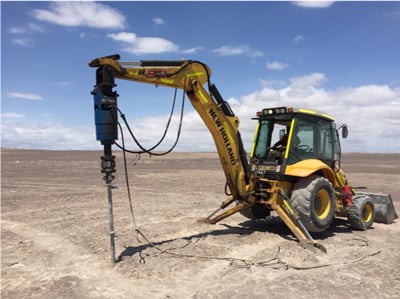 Caliche is best described as salt-cemented sand. Naturally occurring in arid and semi-arid regions, caliche is a dense, thick layer of rock-hard ground that anchor installing machines can barely scratch. CHANCE® engineers, wanting nature’s toughest test for their ROCK-IT™ helical anchor, took product to the Atacama Desert in Chile, to see if the square shaft anchor with a carbide tip welded to the shaft would live up to its name.
Caliche is best described as salt-cemented sand. Naturally occurring in arid and semi-arid regions, caliche is a dense, thick layer of rock-hard ground that anchor installing machines can barely scratch. CHANCE® engineers, wanting nature’s toughest test for their ROCK-IT™ helical anchor, took product to the Atacama Desert in Chile, to see if the square shaft anchor with a carbide tip welded to the shaft would live up to its name.
The Test: ROCK-IT™ Helical Anchor
The first test site was a two-hour drive from the nearest town. A backhoe accompanied the team as a control to confirm the density of the soil. The operator only managed to dig a shallow hole before giving up.
The CHANCE crew originally tested an 8-10-12 inch helical configuration but those plates were too big to penetrate the caliche. Next, they tried another standard helical configuration of 6-8-10 inches and successfully drove it into the ground.
Under normal conditions, a helical anchor of this size would penetrate the soil at the rate of 3 inches per rotation. In the hardest part of the caliche, only ¼ inch depth per rotation was achieved, but the anchor prevailed and, once through the hardest layer, installation resumed at 3 inches per rotation.
The Results: Durability in Rock-Hard Soil
The same anchor was installed, reinstalled, and tested. The product is designed with a carbide tip to break up the soil allowing the extra thick, high strength steel helixes to penetrate the hard soil layers. A 45-ton tensile test at the last site was proof of the anchor’s durability and performance.
Helical Anchor Installation Notes
To function like a deep anchor, the top plate should be under the surface by five times its diameter. In this case, the top plate was 10 inches, so that top helical would need to be 50 inches below the surface when installation is complete.
With any helical anchor installation, it is important to monitor torque throughout the installation. The CHANCE digital torque indicator helps prevent any excess torsional loading with potential to damage an anchor. With such a device, it is possible to install anchors to torque values specified for the job, to ensure proper holding capacities.
ROCK-IT Advantages
Both logistically and practically, CHANCE square shaft anchors with a ROCK-IT lead section are the clear advantage for tough soil conditions. Some advantages include:
- Supplies for multiple helical anchors or tower foundations can be transported to the tower sites on one truck
- No concrete mixers or water tankers needed
- Can be installed with a smaller digger with a drive head attachment
- Installation is relatively quick compared to other options
- Immediate loading after installation (no curing time)
- Minimal ground disturbance in environmentally protected areas
To read the full account of the tests in the Atacama Desert’s caliche soil, read the case study here. To see the products, view the ROCK-IT product line

